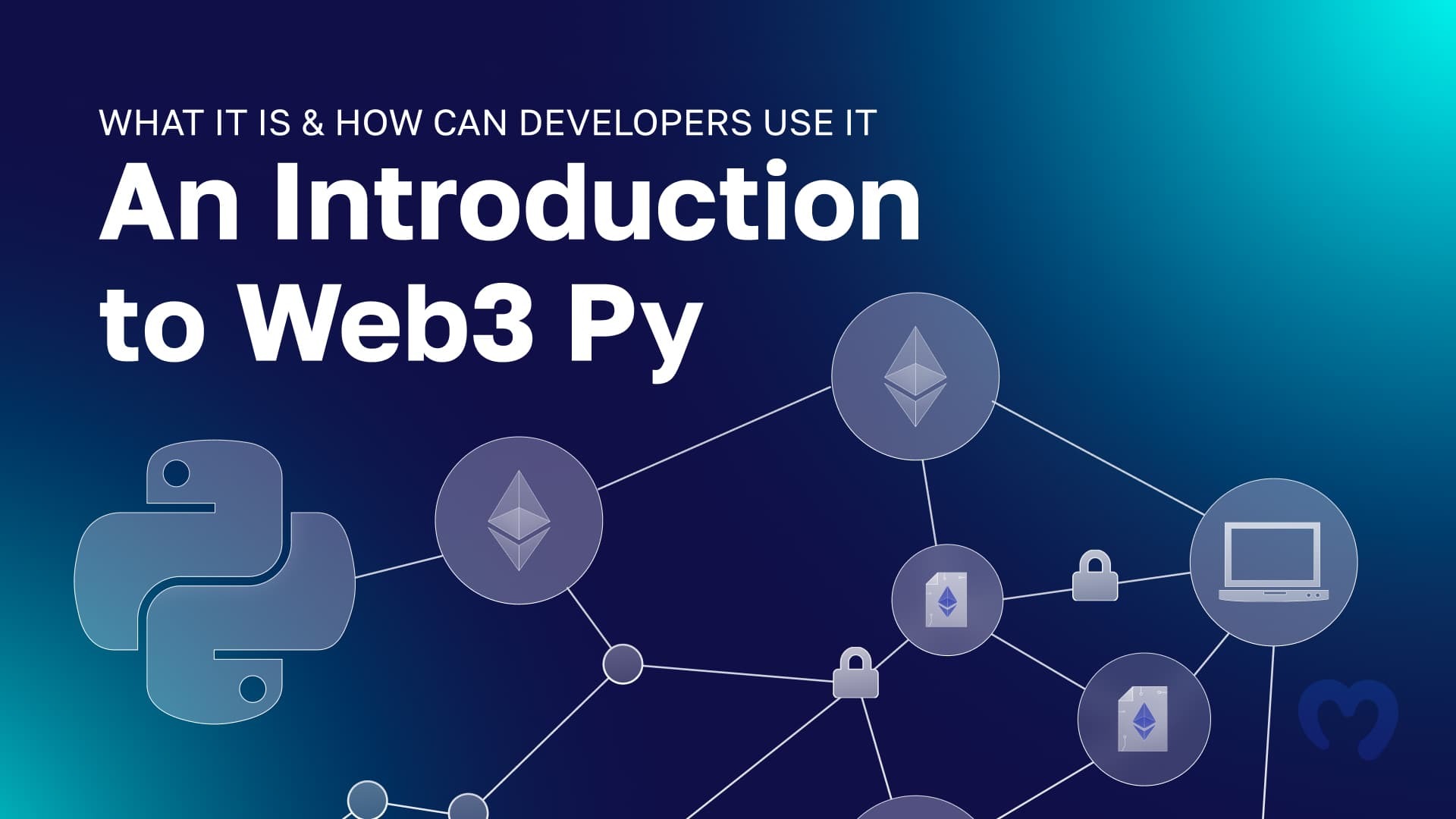Do you know that Moralis’ Python SDK makes Web3 py growth extra accessible? If this sounds thrilling and also you need to be taught extra about constructing Web3-compatible Python tasks, be a part of us on this article as we present exactly how to take action! Because of Moralis and the Python SDK, you possibly can combine Web3 performance into Python purposes in two steps:
Set up Moralis’ Python SDK with the next terminal enter:pip set up moralis Make a Moralis API name. You’ll find an instance of what it will possibly appear to be for querying NFT metadata down beneath: import json
from moralis import evm_api
api_key = “YOUR_API_KEY”
params = {
“tackle”: “0xb47e3cd837dDF8e4c57F05d70Ab865de6e193BBB”,
“token_id”: “3931”,
“chain”: “eth”,
“format”: “decimal”,
“normalizeMetadata”: True,
}
consequence = evm_api.nft.get_nft_metadata(
api_key=api_key,
params=params,
)
print(json.dumps(consequence, indent=4))
For extra examples and particulars in regards to the growth equipment, take a look at Moralis’ Web3 Python SDK documentation! In case you’d like to start out utilizing the above code snippet instantly, join with Moralis now!
Overview
Python is certainly one of as we speak’s hottest programming languages that includes many various use instances. The language’s general-purpose traits make Python appropriate for every little thing from creating easy purposes to machine studying. Furthermore, because of Moralis, it’s now simpler than ever for Python builders to enter the blockchain area. So, if you’re trying to combine Web3 performance into your Python tasks, now you can achieve this simply with Moralis’ Python SDK. If this sounds thrilling, be a part of us on this tutorial as we put the SDK to make use of and offer you a complete introduction to Web3 py growth!
To start with, the article will present a quick overview of Web3 py. In doing so, you’ll higher perceive what Python entails in a Web3 context. From there, the article moreover explores how builders can use Web3 py, the place you might be supplied a quick introduction to Moralis’ Python SDK. Lastly, to high issues off, we are going to present you the right way to create a Web3 py app by using the Python SDK in follow.
Now, if you’re already accustomed to Web3 py and need to broaden your blockchain growth proficiency, you may discover different Moralis articles fascinating. As an example, take a look at our guides on the right way to arrange automated Web3 notification emails or the right way to get NFT collections utilizing Python!
However, it doesn’t matter what Web3 py growth endeavors you embark on, join with Moralis now. Creating your account is free, and you may instantly leverage the complete energy of blockchain expertise!
What’s Web3 Py?
Python is a high-level, object-oriented programming language with an easy-to-learn syntax emphasizing readability. As such, Python is usually a extremely enticing selection for folks trying to get into the event area. Furthermore, this partly contributes to Python’s excessive adoption and is why that is certainly one of as we speak’s hottest programming languages!
Within the context of Web3, there are some things to contemplate concerning Python growth. As an example, should you come straight from standard Web2 practices, there are just a few variations for you to pay attention to earlier than taking over Web3 py growth. As an example, you may need to turn into more adept in utilizing libraries reminiscent of ”Web3.py”. This can be a Web3 py-based library enabling you to work together with the Ethereum community seamlessly.
For Web3 py growth, you may additionally need to discover some instruments that may make your life as a blockchain developer simpler. If this sounds thrilling and also you need to be taught extra about Web3 py, be a part of us within the subsequent part, the place we reply the query, ”how can builders use Web3 py?”.
How Can Builders Use Web3 Py?
Amongst all of the obtainable blockchain infrastructure firms, Moralis provides the main Web3 infrastructure resolution, supplying instruments reminiscent of SDKs, enterprise-grade Web3 APIs, and far more. As such, Moralis opens the door to Web3 growth, enabling anybody to make the most of the complete energy of blockchain expertise to construct Web3 tasks extra simply.
Moreover, amongst Moralis’ Web3 growth instruments, you’ll find the Python SDK. This software program growth equipment is the last word Web3 py device, enabling you to create refined Python blockchain tasks with increased effectiveness and effectivity!
As such, because of Moralis’ capabilities and the Python SDK, this presents the easiest way wherein builders can use Web3 py. What’s extra, Moralis options cross-chain compatibility, which means you could create Web3 py tasks for a lot of totally different networks, together with Ethereum, Solana, BNB Chain, and extra supported Web3 networks!
If this sounds thrilling and also you need to be taught extra about this final Web3 py growth device, be a part of us within the continuing sections, the place we use the SDK to indicate you the right way to create a Web3 and Python software in follow!
Instance of How one can Use Web3 Py
Now that you’ve a extra intensive understanding of Web3 py and Moralis’ Python SDK, it’s time for the central a part of this tutorial. As such, the next sections train you the right way to construct a Web3 py software enabling customers to log in with their MetaMask wallets.
By following alongside, you’ll discover ways to construct a Web3 py-backed software dealing with your entire Web3 authentication circulation. Together with the backend code, additionally, you will discover ways to briefly arrange a frontend React software for demonstrating the auth mechanism in motion! Furthermore, for simplicity, the tutorial is split into the next three sections:
What Are You Working Towards? – Software DemoCreate the Python Flask AppReact Frontend Software Setup
Maybe you favor watching movies to teach your self? In that case, take a look at the video beneath from Moralis’ YouTube channel. On this clip, you might be supplied a whole walkthrough of your entire course of from begin to end by certainly one of our proficient software program engineers:
In any other case, be a part of us for the rest of this Web3 py tutorial, beginning with an software demo to indicate you what you might be working in direction of!
What Are You Working Towards? – Software Demo
Earlier than exploring the Web3 py instance in follow, this part supplies an software demo of the ultimate product. In doing so, you get a greater understanding of what you might be working in direction of, making it simpler to visualise the core performance of the code. However, you’ll discover a print display screen of the app’s touchdown web page down beneath:
The applying’s UI options two core components: a heading and a ”Login” button. In case you click on on this button, it’ll autonomously immediate your MetaMask, permitting you to attach your Web3 pockets. As quickly as you authenticate, the app sends a ”problem” request to the Python backend. Additional, it’ll ask the Moralis Auth API to generate a Web3 login problem.
From there, the app sends yet one more request for validating your signature. If it’s a match – and it’s your first time logging in – the app creates a brand new consumer ID and shows it on the consumer web page:
When you check in, Moralis makes use of the brand new ID to generate a brand new consumer. This consumer is then autonomously added to the ”Consumer” tab in your Moralis admin panel:
However, that covers this demo and the app’s core performance! Now that you’ve a extra profound understanding of what you might be working in direction of, let’s leap straight into the following part, the place we illustrate the right way to create the Python Flask app!
Create the Python Flask App
On this preliminary half, we are going to begin by displaying you the right way to arrange a Web3 py venture. To kick issues off, open your most popular built-in growth surroundings (IDE) and create a brand new Python venture. Throughout this tutorial, we are going to use Visible Studio Code (VSC). So, should you go for one more possibility, the method may sometimes differ.
Nonetheless, after you have launched your IDE and created a venture, go forward and open a brand new terminal. In case you additionally went for VSC, you are able to do so by clicking on ”Terminal” on the high, adopted by ”New Terminal”:
From there, ”cd” into the venture’s root folder, enter the command beneath into the terminal, and hit enter:
python3 -m venv venv
The command above is used to create a brand new digital surroundings. As such, when you run this, it robotically creates a brand new ”venv” folder in your IDE:
With the digital surroundings at your disposal, you moreover must initialize it, which you are able to do by working the command beneath:
supply venv/bin/activate
Subsequent, guarantee that you’ve the most recent model of ”pip” by means of this terminal enter:
pip set up –upgrade pip
Lastly, the ultimate a part of organising the venture is putting in the required dependencies. On this case, there are three in whole, and you’ll discover the set up instructions beneath. Be sure to run every command in consecutive order:
pip set up flaskpip set up flask_corspip set up moralis
That covers the preliminary setup course of for the venture. Subsequent up, within the following part, we present you the right way to add the code from the Web3 py Flask software!
Python Flask App Code
With the barebones state of the venture, now you can proceed by including the Web3 py Flask software code. So, to kick issues off, create a brand new file known as ”app.py” within the root folder of your venture. From there, open it and add the imports for the required dependencies:
from flask import Flask
from flask import request
from moralis import auth
from flask_cors import CORS
After the imports, add the code snippet beneath to initialize the applying and wrap it in ”CORS”:
app = Flask(__name__)
CORS(app)
You may then create a brand new variable in your Moralis API key:
api_key = “xxx”
Be sure you substitute ”xxx” throughout the code along with your API key. You may simply get the important thing if in case you have a Moralis account. That stated, if in case you have not already, be a part of Moralis instantly!
With an account at hand, it is possible for you to to search out the important thing underneath the ”Web3 APIs” tab:
Subsequent up, you should add the ”/requestChallenge” and ”/verifyChallenge” routes.
”/requestChallenge”: Everytime you authenticate your self by means of the applying, this preliminary route requests a problem from Moralis. Furthermore, the central a part of the ”/requestChallenge” route is the ”reqChallenge()” perform. The perform is liable for getting the request arguments, including a variable known as ”physique”, buying the outcomes from the ”/requestChallenge” endpoint, and at last passing the outcomes to the shopper: @app.route(‘/requestChallenge’, strategies=[“GET”])
def reqChallenge():
args = request.args
physique = {
“area”: “my.dapp”,
“chainId”: args.get(“chainId”),
“tackle”: args.get(“tackle”),
“assertion”: “Please affirm login”,
“uri”: “https://my.dapp/”,
“expirationTime”: “2023-01-01T00:00:00.000Z”,
“notBefore”: “2020-01-01T00:00:00.000Z”,
“assets”: [‘https://docs.moralis.io/’],
“timeout”: 30,
}
consequence = auth.problem.request_challenge_evm(
api_key=api_key,
physique=physique,
)
return consequence ”/verifyChallenge”: When you signal the message, the applying returns the outcomes to the backend and verifies it utilizing the opposite ”/verifyChallenge” route. This route accommodates the ”verifyChallenge()” perform, which will get the arguments from the request, creates the ”physique” variable, fetches the consequence from the Moralis Auth API endpoint, and lastly, returns it to the shopper: @app.route(‘/verifyChallenge’, strategies=[“GET”])
def verifyChallenge():
args = request.args
physique={
“message”: args.get(“message”),
“signature”: args.get(“signature”),
}
consequence = auth.problem.verify_challenge_evm(
api_key=api_key,
physique=physique
)
return consequence
Lastly, after the 2 routes, add the code snippet beneath to specify the place you need to run the applying:
if __name__ == “__main__”:
app.run(host=”127.0.0.1″, port=3000, debug=True)
Now that’s it for your entire code of the ”app.py” file! All in all, it ought to now look one thing like this:
from flask import Flask
from flask import request
from moralis import auth
from flask_cors import CORS
app = Flask(__name__)
CORS(app)
api_key = “xxx”
@app.route(‘/requestChallenge’, strategies=[“GET”])
def reqChallenge():
args = request.args
physique = {
“area”: “my.dapp”,
“chainId”: args.get(“chainId”),
“tackle”: args.get(“tackle”),
“assertion”: “Please affirm login”,
“uri”: “https://my.dapp/”,
“expirationTime”: “2023-01-01T00:00:00.000Z”,
“notBefore”: “2020-01-01T00:00:00.000Z”,
“assets”: [‘https://docs.moralis.io/’],
“timeout”: 30,
}
consequence = auth.problem.request_challenge_evm(
api_key=api_key,
physique=physique,
)
return consequence
@app.route(‘/verifyChallenge’, strategies=[“GET”])
def verifyChallenge():
args = request.args
physique={
“message”: args.get(“message”),
“signature”: args.get(“signature”),
}
consequence = auth.problem.verify_challenge_evm(
api_key=api_key,
physique=physique
)
return consequence
if __name__ == “__main__”:
app.run(host=”127.0.0.1″, port=3000, debug=True)
Begin the App
Now that you’ve added the Web3 py Flask software code, all that is still is to launch the venture. That is comparatively easy, and all you should do is open a brand new terminal and run this command:
python3 app.py
Working the command above will spin up the Web3 py Flask software on “localhost 3000“, which we specified earlier. From right here, allow us to dive into the following part of the tutorial, the place we briefly present you the right way to arrange the frontend React software, enabling you to check the endpoints!
React Frontend Software Setup
Now that you’ve launched the Web3 py Flask backend software, the very last thing you should do is about up the frontend. From that frontend, you possibly can deal with the Web3 authentication circulation and name the endpoints. With the intention to make this as accessible as attainable, we’ve already constructed a reusable frontend React software. So, all you should do is go to the GitHub repo down beneath and clone the venture:
Full Web3 Py Instance Documentation – https://github.com/MoralisWeb3/youtube-tutorials/tree/most important/Web3AuthPython
By cloning the repository, you need to end up with a file construction in your native listing much like the one beneath:
Lastly, all that is still is to open a brand new terminal and run this command to launch the app:
npm run begin
Congratulations! You may have now accomplished this Web3 py tutorial! In order for you a extra detailed breakdown of the frontend code, take a look at the clip from the sooner ”Instance of How one can Use Web3 Py” part. You can even discover extra info on Web3 py by testing Moralis’ Web3 Python SDK documentation!
What’s Web3 Py – Abstract
This text taught you the right way to create a simple Web3 Python app utilizing Moralis’ Python SDK. The tutorial was divided into three most important sections:
What Are You Working Towards? – Software DemoCreate the Python Flask AppReact Frontend Software Setup
By following alongside, you now know the right way to combine Web3 performance into Python purposes simply with Moralis! As such, now you can implement the identical elementary ideas in future Web3 growth endeavors and, as an illustration, use Python for Ethereum growth!
In case you discovered this tutorial thrilling, take into account testing different featured articles right here on Moralis’ Web3 weblog. As an example, learn up on ERC 1155 NFTs or discover ways to get all tokens owned by a pockets!
Nonetheless, if you’re occupied with additional Web3 py growth, do your self a favor and join with Moralis instantly. To entry the superb instruments of Moralis, just like the Web3 APIs, you want a Moralis account. Create one completely totally free!
































